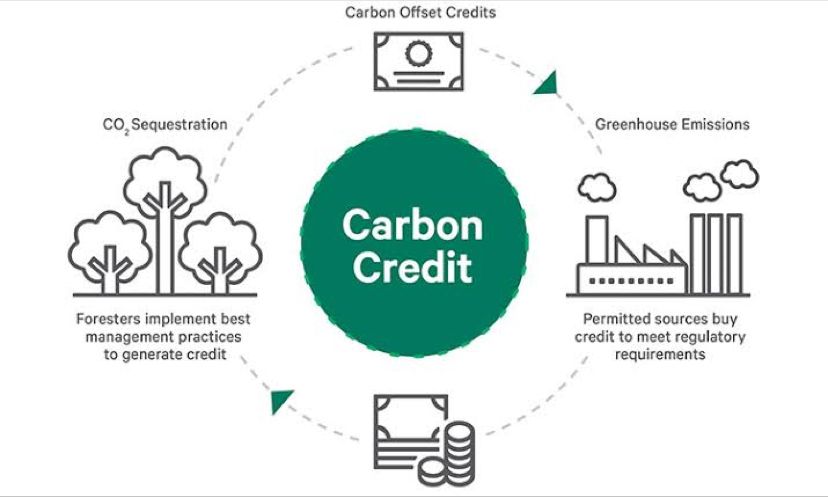Carbon credits are a crucial component of global efforts to combat climate change. In a world where carbon emissions contribute significantly to the greenhouse effect and the resultant global warming, carbon credits offer a mechanism for incentivizing emissions reduction and promoting sustainable practices. This comprehensive exploration delves into the intricacies of carbon credits, including their definition, types, trading mechanisms, benefits, challenges, and the broader impact on the environment and economy. By examining the evolution and current state of carbon credit initiatives, this article seeks to provide a thorough understanding of their role in shaping a more sustainable future.
Introduction:-
Carbon credits are a market-based approach to mitigating greenhouse gas emissions. They represent a quantified reduction in emissions achieved through various projects or activities. These credits can be bought and sold, allowing businesses and governments to offset their carbon footprints by investing in projects that reduce or capture carbon dioxide. The concept aims to incentivize sustainable practices and contribute to global efforts to combat climate change.
Types or carbon credits :-
1:-Carbon Offset Credits: These are generated by projects that reduce, avoid, or remove greenhouse gas emissions, such as reforestation, renewable energy projects, or methane capture from landfills.
2:-Renewable Energy Credits (RECs): These are generated by renewable energy projects like wind, solar, or hydro power, and represent the environmental attributes of the energy produced.
3:-Emission Reduction Credits (ERCs): These credits come from projects that reduce emissions from specific sources, such as industrial processes or vehicle fleets.
4:-Verified Emission Reductions (VERs): Also known as voluntary carbon credits, these are often used by individuals or organizations that want to offset their carbon footprint outside of regulatory requirements.
5:-Cap and Trade Allowances: These are used in cap-and-trade systems, where a government sets a cap on total emissions and issues allowances that companies can trade. This encourages emission reduction and rewards efficient companies.
6:-Certified Emission Reductions (CERs): These are generated under the Clean Development Mechanism (CDM) of the Kyoto Protocol. CERs are generated from emission reduction projects in developing countries.
7:-Removal Units (RMUs): These are generated by projects that remove greenhouse gases from the atmosphere, such as afforestation or direct air capture.
8:-Offset-in-lieu Programs: These allow regulated entities to purchase carbon credits instead of reducing emissions directly, often as part of regulatory compliance.
Carbon credit project development:-Developing a carbon credits project involves several steps. First, identify a project that reduces or captures carbon emissions, like reforestation or renewable energy. Then, quantify the emissions reduction through methodologies approved by relevant standards (e.g., Verified Carbon Standard). Next, seek project financing and register with a carbon credit registry. After implementation, undergo verification to validate emission reductions. Finally, issue and sell carbon credits to individuals or companies seeking to offset their emissions. This process helps combat climate change while generating revenue for the project.
Carbon credits standard and protocol:-Carbon credit standards and protocols are established frameworks that guide the measurement, verification, and trading of carbon credits. They ensure consistency and transparency in the carbon offset market, helping to address climate change. Some well-known standards include the Verified Carbon Standard (VCS), Gold Standard, and Climate Action Reserve. These standards outline methodologies for calculating emissions reductions, ensuring projects are genuine and impactful, and providing a basis for trading carbon credits.
Benefits of carbon credits:-
1:-Emissions Reduction: Carbon credits incentivize the reduction of greenhouse gas emissions by attaching a monetary value to each ton of CO2. This encourages companies to invest in cleaner technologies and practices.
2:-Technology Transfer: Emissions reduction projects often require innovative technologies. Carbon credit financing can facilitate the transfer of these technologies from developed to developing countries, promoting sustainable development.
3:-Economic Opportunities: Carbon credit projects create new economic opportunities in sectors such as renewable energy, afforestation, and waste management. They stimulate job creation and economic growth.
4:-Global Cooperation: Carbon credits promote international cooperation in addressing climate change. Developed countries can support emissions reduction projects in developing nations, fostering a collaborative approach.
Criticisms and Challenges:
1:-Additionality: Critics argue that some carbon credit projects might not be additional, meaning they would have happened even without the financial incentive of carbon credits.
2:-Permanence: There’s a concern that projects such as afforestation or reforestation may not guarantee the permanent storage of carbon, as trees can be susceptible to natural disasters or deforestation.
3:-Complexity: The carbon credit market can be complex, with varying standards and methodologies for calculating emissions reductions. This complexity can lead to challenges in verifying the actual impact of projects.
4:-Ethical Concerns: Some critics question the ethics of emissions trading, suggesting that it allows developed countries to continue emitting at high levels by purchasing credits from developing nations.
In conclusion, carbon credits play a crucial role in the fight against climate change by incentivizing emissions reduction and supporting sustainable development. Despite challenges and criticisms, they remain a valuable tool in the broader effort to mitigate global warming. As the world continues to grapple with the impacts of climate change, carbon credits offer a mechanism that combines economic incentives with environmental responsibility, fostering a more sustainable future for generations to come.

